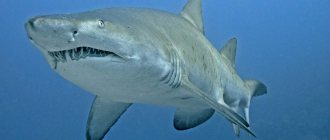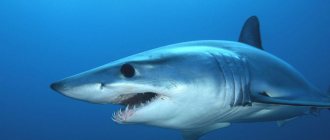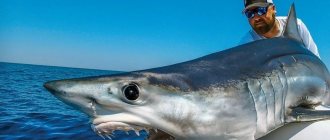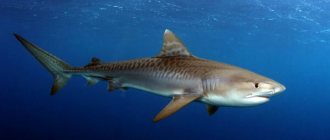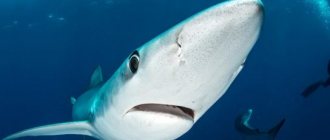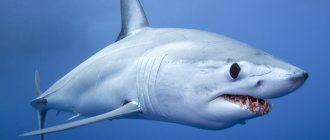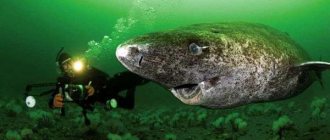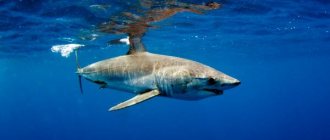Even in the depths of the sea there are workers who honestly “earn” their bread, that is, fish, fox shark or sea fox (Alopias).
Despite its large dimensions, the fox shark has no particular desire to attack a person, since it feeds on schooling fish, but if it is really hungry, it sets off in pursuit of swimming invertebrates and even dolphins.
Undoubtedly, this fish should be considered dangerous, if only because of its size or amazing tail, which is a formidable weapon not only for marine life.
Carpet shark or bearded wobbegong
Agree, it doesn’t look like a shark at all. These bottom-dwelling marine animals, common in warm waters, grow to a length of just over a meter, but sometimes three-meter-long individuals are also found. The wobbegong's body is flat, widening towards the head with a rather unattractive snout, expressionless unblinking eyes, small teeth and skin growths reminiscent of a beard. With them, the carpet shark “combs” the seabed, looking for food - crabs, shrimp, mollusks, echinoderms and small fish. The spotted skin allows the bearded wobbegong to camouflage well on the bottom, blending in with corals and algae.
Interesting fact. Almost all shark species need to move in order to breathe. Wobbegongs can breathe without moving. These are sedentary animals. Consequently, they burn fewer calories, so they need little food.
Carpet sharks are not dangerous to people, although you should not touch them or grab them by the tail - they can bite.
Appearance and features
Photo: What a big-eyed fox shark looks like
In length, adult individuals grow to 3.5-4, the largest specimen caught reached 4.9 m. They weigh 140-200 kg. Their body is spindle-shaped and their snout is sharp. The mouth is small, curved, there are a lot of teeth, about two dozen rows below and above: their number can vary from 19 to 24. The teeth themselves are sharp and large.
The most obvious sign of fox sharks: their tail fin is extremely extended upward. Its length can be approximately equal to the length of the fish’s entire body, so this disproportion in comparison with other sharks will be immediately noticeable, and representatives of this species will not be confused with anyone else.
Also, as their name suggests, they are distinguished by the fact that they have large eyes - their diameter can reach 10 cm, which in relation to the size of the head is larger than that of other sharks. Thanks to such large eyes, these sharks see well in the dark, where they spend most of their lives.
It is also noteworthy that the eyes are very elongated, thanks to which these sharks are able to look straight up without turning. The skin of this fish alternates between two types of scales: large and small. Its color can be brown with a strong hint of lilac or deep purple. It is preserved only during life; a dead shark quickly turns gray.
fox shark
Fox shark
Its other names are “sea fox” or “sea thresher”. The most prominent part of this shark's body is its large tail. She does not need it for beauty or for ease of swimming, but for hunting. Seeing the fish, the fox shark begins to circle around them, waving its tail and driving the fish into a dense school. Then the shark dives down the “fish pile”, positioning its tail up, and hits the “potential dinner” with force. The speed of the tail at this moment is 80 km/h, so the fish caught under it has no chance to escape. Hence the name – “sea thresher”. The shark is very voracious, so it quickly begins to grab stunned fish. If its stomach is already full, and the fish killed by its tail are still on the surface of the water, the fox shark regurgitates part of the eaten fish and begins to devour those still floating on the water. Here is a vivid example of boundless greed! The fox shark can also hunt live fish, even jumping out of the water. This often serves it poorly, since a careless shark often manages to get its prominent tail caught in fishing gear.
Elephant shark or giant shark
Elephant shark
This giant with a laterally compressed body and a head with a short trunk grows up to 10 meters in length and weighs more than 4 tons. The mouth of this shark is so large (up to three meters in diameter) that small teeth are completely invisible. It would seem that having such a mouth, one can easily feed on large animals. But no. The elephant shark only eats plankton. She, swimming slowly with her mouth open, pumps a huge amount of water with plankton into it, then filters the water through the gills, and swallows the plankton. Its stomach can hold up to a ton of food.
The giant shark has another name - “basking shark”, since it loves to swim on the very surface of the water, exposing its powerful body to the warm sun. The giant shark feeds especially actively in the summer and spring, and in the cold season, when there is less plankton, it either feeds on the fat reserves of the liver or descends to greater depths (up to 1 km) in search of plankton.
The liver of this shark makes up 1/5 of its weight, the fat is considered very useful for humans, and the meat and bones are used in humans. Therefore, these giants are being destroyed en masse. It's a pity, because they are completely harmless.
Social structure and reproduction
Photo: Big-eyed fox sharks
They live alone, gathering only during hunting, as well as during reproduction. It can happen in any season. During fetal development, embryos first eat the yolk, and after the yolk sac is empty, they begin to eat unfertilized eggs. They do not eat other embryos, unlike many other sharks.
It is not known how long gestation lasts, but this shark is viviparous, that is, fry are born immediately, and there are not many of them - 2-4. Due to the small number of embryos, big-eyed sharks reproduce slowly, but there is an advantage to this - the length of the sharks that have barely been born is already quite impressive, it is 130-140 cm.
Thanks to this, newborns can almost immediately fend for themselves, and they are not afraid of many predators that torment sharks of other species in the first days or weeks of life. Outwardly, they already strongly resemble an adult, except that the head looks larger in comparison with the body, and the eyes stand out even more than in adult sharks of this species.
Big-eyed sharks are even born already covered with fairly dense scales, which can serve as protection - therefore, the inside of the oviduct in females is covered with epithelial tissue, protecting it from damage by the sharp edges of these scales. In addition to the small number of sharks born at a time, there is another important problem during their reproduction: males reach sexual maturity by 10 years, and females a few years later. Considering that they only live 15-20 years, this is very late; usually females manage to give birth 3-5 times.
Hammerhead shark
Hammerhead shark
The hammerhead shark is one of the largest sharks (from 5 to 7 meters) and one of the most ancient fish on our planet (more than 25 million years old). Its weight can reach 350 kg. These sharks live in warm seas.
This shark has a very unusual head, with two lobes located on the sides, on which small eyes and special organs for catching smell are visible. The hammerhead shark is very voracious and indiscriminate in food: it eats both large animals and its shark relatives.
“Potential food”, trying to hide from this predator, buries itself in the sand, but in vain. The hammerhead shark picks up the impulses coming from their bodies with its head, rushes at them and literally tears the frightened, trembling fish out of the sand. The hammerhead shark is also dangerous to humans.
Main differences. Common fox
The common fox shark has a streamlined body shape with a distinctly curved back. She has a cone-shaped short head with medium-sized eyes that lack a third eyelid. The predator's teeth are small, fang-like, slightly flattened. The average size of sharks is about five meters. At the same time, a maximum was recorded - more than 7 m, and a minimum - less than four.
The shark's body color is heterogeneous. There were individuals of dark brown, blue-gray, and steel color. Some fish had a black back and a light belly.
Longtip shark
Longtip shark
This is a very aggressive and slow shark, common in warm seas. She waits patiently for some prey to come into her field of vision. And when this happens, for example, a school of fish appears, the long-winged shark begins to greedily grab food. After the meal of these sharks, many half-eaten animals or fish float on the surface of the bloody water.
She does not disdain human meat either. For example, in the forties of the last century, a ship with a thousand passengers on board crashed near South Africa. Almost all the people who fell into the water were devoured alive by long-tipped sharks.
Long-winged sharks circle close to sailing ships, grabbing everything that is thrown out of them. Bales of garbage were sometimes found in the wombs of caught sharks.
Long-winged sharks are caught by people for their large fins, which are used as food.
cat shark
Cat shark
This small shark, spotted like a cat (maximum 1m 20 cm), leads a sedentary lifestyle in warm seas, among corals. During the day she lies motionless, hiding in the corals, and at night she goes in search of food. The shark probes the bottom with its antennae and looks for small fish and crustaceans.
Amazing fact. These interesting animals have adapted to go without water for more than ten hours. This feature has developed over many centuries, resulting from the fact that the tide often leaves these sharks on the shore.
Cat sharks are often kept in aquariums.
Largemouth shark
Largemouth shark
The largemouth shark is one of the least studied marine animals and the rarest fish in the world. It was first discovered in 1976, since then people have discovered only 47 of these animals.
The weight of these five-meter giants with a large head and a meter-long thick-lipped mouth is one and a half tons. They feed on krill, and they do it in a very interesting way. Their mouth has a luminous surface from the inside, which attracts small animals and plankton. This is the largest luminous sea animal! Having captured a huge amount of water and “food”, the giant filters the water and pushes the food down its throat with its huge tongue. If a particularly nimble victim tries to escape from the jaws of the lip-slapper, then small teeth arranged in 23 rows of 300 pieces in each stand in its way!
The largemouth shark has a watery body that prevents it from drowning. But it often becomes prey for other predators. A clumsy and very slow shark can be attacked by a school of rock perches, which tear pieces out of its body with their sharp teeth. It can also be swallowed whole by a sperm whale.
Glowing sharks
Glowing Shark
Glowing sharks are very aggressive fish, but one thing distinguishes them from their counterparts: they do not kill victims, but only bite off the part they like and swim away. Their diet includes whales, killer whales, swordfish, or even their brothers, the same glowing sharks. But sometimes they also become someone's lunch. One day, a glowing shark was found in the stomach of a large tuna.
These 50cm sharks live in warm seas. During the day they live at great depths (sometimes up to 3 km), and at night they rise to the surface.
Origin of the species and description
Photo: Big-eyed fox shark
The species described was R.T. Lowe in 1840 and was named Alopias superciliosus. Subsequently, Lowe's description was revised several times along with its place in the classification, which means the scientific name also changed. But this is a rare case when the first description turned out to be the most correct, and exactly a century later the original name was restored.
Alopias is translated from Greek as “fox”, super from Latin “above”, and ciliosus – “eyebrow”. Fox - because since ancient times, sharks of this species were considered cunning, and the second part of the name was obtained due to one of the characteristic features - the depressions above the eyes. The origin of the species goes back to ancient times: the first of the direct ancestors of sharks swam the earth’s oceans back in the Silurian period. It was from that time that fish with a similar body structure date back, although it is not established exactly which of them gave rise to sharks.
Video: Big-eyed fox shark
The first of the true sharks appear by the Triassic period and quickly flourish. Their structure gradually changes, calcification of the vertebrae occurs, due to which they become stronger, and therefore faster and more maneuverable, and also gain the ability to settle at great depths.
Their brain grows - sensory areas appear in it, thanks to which the sharks’ sense of smell becomes extraordinary, so that they begin to sense blood even when they are tens of kilometers from the source; The jaw bones are improved, making it possible to open the mouth wide. Gradually, during the Mesozoic, they became more and more similar to those sharks that live on the planet now. But the last significant impetus for their evolution comes from extinction at the end of the Mesozoic era, after which they become almost undivided masters of sea waters.
During all this time, the already ancient superorder of sharks continued to give rise to more and more new species due to environmental changes that took place. And big-eyed sharks turned out to be one of the young species: they appeared only in the middle Miocene, this happened approximately 12-16 million years ago. Since this time, a large number of fossil remains of this species have been discovered, before which they were absent; a little earlier, representatives of the pelagic fox shark, closely related to them, appeared - they descended from one common ancestor.
